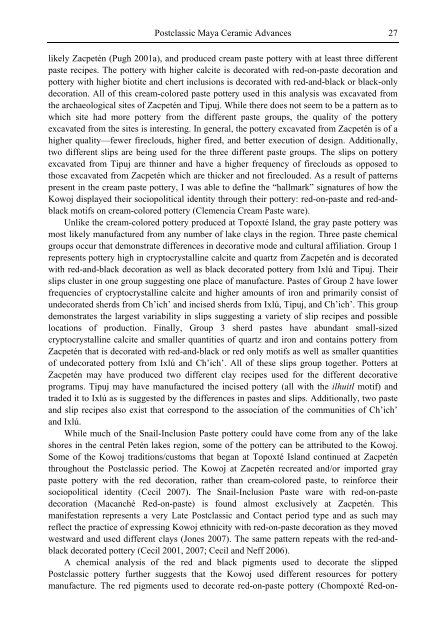Developments in Ceramic Materials Research
Developments in Ceramic Materials Research
Developments in Ceramic Materials Research
You also want an ePaper? Increase the reach of your titles
YUMPU automatically turns print PDFs into web optimized ePapers that Google loves.
Postclassic Maya <strong>Ceramic</strong> Advances 27<br />
likely Zacpetén (Pugh 2001a), and produced cream paste pottery with at least three different<br />
paste recipes. The pottery with higher calcite is decorated with red-on-paste decoration and<br />
pottery with higher biotite and chert <strong>in</strong>clusions is decorated with red-and-black or black-only<br />
decoration. All of this cream-colored paste pottery used <strong>in</strong> this analysis was excavated from<br />
the archaeological sites of Zacpetén and Tipuj. While there does not seem to be a pattern as to<br />
which site had more pottery from the different paste groups, the quality of the pottery<br />
excavated from the sites is <strong>in</strong>terest<strong>in</strong>g. In general, the pottery excavated from Zacpetén is of a<br />
higher quality—fewer fireclouds, higher fired, and better execution of design. Additionally,<br />
two different slips are be<strong>in</strong>g used for the three different paste groups. The slips on pottery<br />
excavated from Tipuj are th<strong>in</strong>ner and have a higher frequency of fireclouds as opposed to<br />
those excavated from Zacpetén which are thicker and not fireclouded. As a result of patterns<br />
present <strong>in</strong> the cream paste pottery, I was able to def<strong>in</strong>e the “hallmark” signatures of how the<br />
Kowoj displayed their sociopolitical identity through their pottery: red-on-paste and red-andblack<br />
motifs on cream-colored pottery (Clemencia Cream Paste ware).<br />
Unlike the cream-colored pottery produced at Topoxté Island, the gray paste pottery was<br />
most likely manufactured from any number of lake clays <strong>in</strong> the region. Three paste chemical<br />
groups occur that demonstrate differences <strong>in</strong> decorative mode and cultural affiliation. Group 1<br />
represents pottery high <strong>in</strong> cryptocrystall<strong>in</strong>e calcite and quartz from Zacpetén and is decorated<br />
with red-and-black decoration as well as black decorated pottery from Ixlú and Tipuj. Their<br />
slips cluster <strong>in</strong> one group suggest<strong>in</strong>g one place of manufacture. Pastes of Group 2 have lower<br />
frequencies of cryptocrystall<strong>in</strong>e calcite and higher amounts of iron and primarily consist of<br />
undecorated sherds from Ch’ich’ and <strong>in</strong>cised sherds from Ixlú, Tipuj, and Ch’ich’. This group<br />
demonstrates the largest variability <strong>in</strong> slips suggest<strong>in</strong>g a variety of slip recipes and possible<br />
locations of production. F<strong>in</strong>ally, Group 3 sherd pastes have abundant small-sized<br />
cryptocrystall<strong>in</strong>e calcite and smaller quantities of quartz and iron and conta<strong>in</strong>s pottery from<br />
Zacpetén that is decorated with red-and-black or red only motifs as well as smaller quantities<br />
of undecorated pottery from Ixlú and Ch’ich’. All of these slips group together. Potters at<br />
Zacpetén may have produced two different clay recipes used for the different decorative<br />
programs. Tipuj may have manufactured the <strong>in</strong>cised pottery (all with the ilhuitl motif) and<br />
traded it to Ixlú as is suggested by the differences <strong>in</strong> pastes and slips. Additionally, two paste<br />
and slip recipes also exist that correspond to the association of the communities of Ch’ich’<br />
and Ixlú.<br />
While much of the Snail-Inclusion Paste pottery could have come from any of the lake<br />
shores <strong>in</strong> the central Petén lakes region, some of the pottery can be attributed to the Kowoj.<br />
Some of the Kowoj traditions/customs that began at Topoxté Island cont<strong>in</strong>ued at Zacpetén<br />
throughout the Postclassic period. The Kowoj at Zacpetén recreated and/or imported gray<br />
paste pottery with the red decoration, rather than cream-colored paste, to re<strong>in</strong>force their<br />
sociopolitical identity (Cecil 2007). The Snail-Inclusion Paste ware with red-on-paste<br />
decoration (Macanché Red-on-paste) is found almost exclusively at Zacpetén. This<br />
manifestation represents a very Late Postclassic and Contact period type and as such may<br />
reflect the practice of express<strong>in</strong>g Kowoj ethnicity with red-on-paste decoration as they moved<br />
westward and used different clays (Jones 2007). The same pattern repeats with the red-andblack<br />
decorated pottery (Cecil 2001, 2007; Cecil and Neff 2006).<br />
A chemical analysis of the red and black pigments used to decorate the slipped<br />
Postclassic pottery further suggests that the Kowoj used different resources for pottery<br />
manufacture. The red pigments used to decorate red-on-paste pottery (Chompoxté Red-on-
















